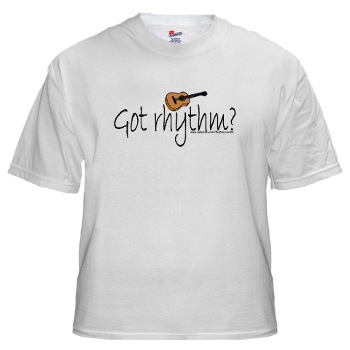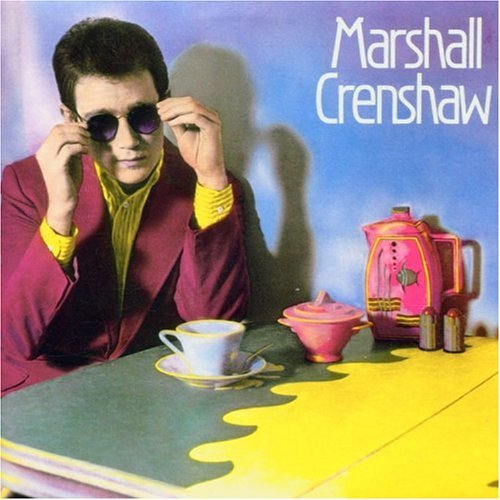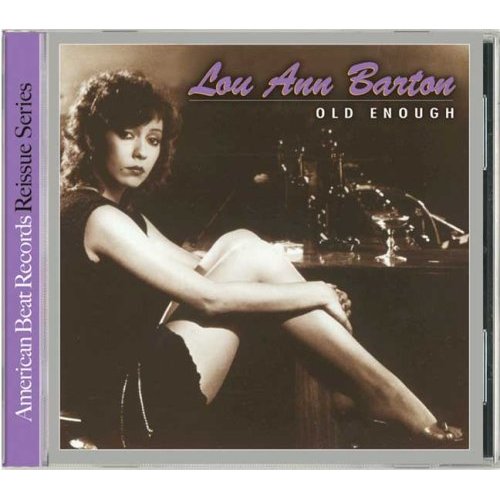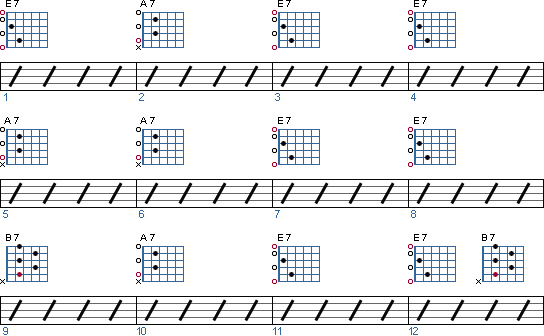Rhythm guitar. It’s a lost art. Go to any guitar store and listen to the people trying out guitars. Nobody is playing chords. I learned to play guitar from The Beatles’ songbooks and only started playing lead much later. But these durned kids nowadays don’t seem to understand the art of accompaniment, though admittedly guitar-hero disease goes back to the late ’60s.

In the punk era, lead guitar was kind of frowned on. And then in power pop/new wave music there was more of an appreciation of songcraft and more of a focus on rhythm guitar as a basic building block of great pop music.

Marshall Crenshaw actually became a pretty accomplished guitar player, but on his first album the songs are more typically built on simple but effective rhythm guitar riffs. “Brand New Lover,” the song that ends the album is a great example. It’s open with a nice, funky riff; works through some very clever modulations; and generally gives off a genially horny urgency appropriate to its straightforward lyrical theme. Marshall needs a brand new lover. Rightnow rightnow RIGHTNOW.
Marshall Crenshaw, “Brand New Lover”
At the time lots of people wanted to cover Crenshaw’s songs. Not long after his debut album came out, Texas rhythm & blooz chantooz Lou Ann Barton recorded “Brand New Lover” on her own debut album, Old Enough.

The album was recorded in Muscle Shoals and produced by Jerry Wexler (and Glenn Frey, but we’re going to let that go). Most importantly it was recorded with the Muscle Shoals rhythm section. A number of guitar players are credited on the album, including Frey and Wayne Perkins, famous for having played the lead part on Bob Marley’s “Concrete Jungle” and for supposedly almost joining the Stones. But almost certainly it’s rhythm guitar genius Jimmy Johnson we hear anchoring this version of the song.
Lou Ann Barton, “Brand New Lover”
The opening riff here is just awesomely funky. This is really Rhythm Guitar 101, even though it’s not something you can really teach. I don’t want to say Crenshaw sounds wooden by comparison, because there’s certainly nothing wrong with his version, and obviously he came up with the riff itself. But Johnson adds a swing to it that Crenshaw just doesn’t have access to. Now his part is doubled, with the each track panned left and right, but I don’t think that’s really where the rhythm resides. It’s in Jimmy Johnson’s fingertips. The rest of the rhythm section really brings the song home, and Barton’s sassy vocal doesn’t hurt. In fact it’s interesting how a woman singing “I need a brand new lover” just has a different tone than a man singing it.
Anyway I think her recording is an object lesson in what a good rhythm guitar player can bring to a song. What are some of your favorite rhythm guitar parts? If an earnest young guitar player came to you, willing to forgo guitar-hero status and wanting to learn how to serve the song, what are the tracks you’d point him toward?



Your arpeggiophobic moderator is all about the rhythm guitar. Rhythm guitar, bass, and drums are usually what I’m listening for the first few times I hear a song. I’ve always loved John Lennon’s pinky rock rhythm parts. He fully commits. I love the early Stones best because Keith and Brian play nothing but rhythm – and they too commit. The Clash committed to the downbeat.
The comparison BigSteve makes on these two versions of the Crenshaw tune is clear to me. I’m not yet thinking about this topic with the detail that BigSteve put into his post, but I do know I gravitate toward rhythms that dig in on the first downstroke. Anyone who’s heard any guitar part I’ve ever played will not be surprised by this. Those first two Stooges albums, for instance, always get going with the guitar digging in on the low end of whatever chord the song is rooted around. That kind of stuff is like the strong cup of coffee I kick off each day with.
Also not that subtle but an arrangement device that always appeals to me is songs with dueling, contrapuntal (?) rhythm parts, like The Buzzcocks’ “Why Can’t I Touch It,” Television’s “Marquee Moon,” and the rhythm guitar(s) on Captain Beefheart’s “Dirty Blue Gene.” Without the rhythmic touch on the last example, that song would not work anywhere as well.
An unusual rhythm part that blows me away is Phil Manzanera’s guitar on “Amazona.”
Hendrix is the god among guitar gods, but I think it’s his rhythmic foundation that puts him so far ahead of the pack. Among guys known for their hot licks, do any come close to him for rhythmic skills?
Hendrix’s rhythmic foundation, of course, reminds me of Curtis Mayfield’s rhythm playing. Listen to what’s going on rhythmically on a song like “Keep on Pushing” or the mellower, skipping triplet chords of “Grow Closer Together.” I can’t imagine pulling off that skipping triplet feel the way he does.
Not very rock and roll, but Nile Rogers from Chic. God, what a sound.
Steve Cropper…on any random Stax number
There are so many to choose from, but I’ll start with a track I was enjoying yesterday: “If You Want Blood” by AC/DC, from “Highway to Hell.” A prime example of how incredibly tight, focused riffing can elevate a song to pretty amazing heights. And without that military-spec tightness in the rhythm section, AC/DC would probably pretty much suck.
No one ever cites his musicianship, but I’ve always loved David Byrne’s guitar playing. I’m guessing those parts of very easy to play, but they really groove and have their own little hooks, even when he’s just playing the same line throughout the song.
I’m not sure if Graham Coxon’s work on Blur songs like “Girls and Boys” and “Beetlebum” is rhythm guitar per se, but I highly approve.
Gang of Four, “I Found That Essence Rare”
BigSteve, this is great stuff!
In the eyes of many, rhythm playing has always been, and will always be in the poor house compared to “virtuosity’s” penthouse.
Just as it was for you, rhythm playing was the foundation for me. And there aint none of the other “fancier” stuff unless you understand them chords and how to play them around, before, behind, and on the beat.
I like Hendrix as a rhythm player, too. And I would show people “You Got Me Floatin'” and “Aint no tellin'” as examples of good rhythm playing. “Foxy Lady” is a testament to just how powerful a good rhythm part can be. It can take over the whole arrangement. It can become the song!
In the I’m-not-so-sure-I-buy-the-notion-that-“rhythm-guitar-playing-is-a-lost-art” category, I would point any young guitar enthusiast in the direction of the Black Keys without hesitation. RTH’ers are familiar with the problems I have with that band, but his guitar playing is not one of ’em. He has a great knack for toying around with the down beat.
But i think butcher pete’s suggestion of Steve Cropper is perhaps the best one.
When I listen to Live at Leeds with the whole concert (including all of Tommy on disc 2) I can’t help thinking that Townshend’s gift is his rhythm guitar playing. He does play some single note stuff, and it’s usually great, but in that band, and particularly that era of their live shows, the bass, and drums are more like “lead” instruments.
Wow, Bakshi…we are men on a mission. On my way to to rehearse this weekend, I grabbed my copies of Big Star and Big Star-related music. (It’s funny in all our Big Star discussion, NO ONE mentioned the reunion album from 2005.) I also grabbed a bunch of AC/DC as I am knee-deep in reading their bio. The first one I threw on was Highway To Hell. “If You Want Blood” ended up getting multiple plays as it kicked my ass every which way. The build up intro into Bon screaming “It’s criminaaaaaal…” Classic.
I always thought The Who were interesting in their setup as the entire band is based in Pete’s rhythm. John and Keith were essentially playing leads while Pete seemed to be grounding the band’s beat. It’s totally backwards in every way.
TB
I’ve always felt like Jimmy Page was an excellent rhythm guitar player, particularly in coming up with great riffs, but I don’t like him much as a lead guitarist.
Agreed, mockcarr, on Page’s strength as a rhythm/riff player without being a good soloist. I’d say the same goes for Townshend.
Bo Diddley,Buddy Holly, John Lennon, Roger McGuinn, Pete Townshend, Keith Richards, Little Steven Van Zant, Malcom Young, Tom Petty, Peter Buck
These are the masters of rhythm guitar in the rock era IMO
I used to teach beginner guitar and I made sure that the students understood how important a solid rhythm guitar was to rock/pop music. I would make a tape of these guys as examples.
Simon Nicol. In a way he’s as important to the sound of early Fairport as Richard Thompson.
We’re dancing around it already, but how would you characterize the key role of highly effective rhythm guitar? It’s more than simply “locking in” with another musician, as we might say in vague studio speak, right? Certainly there’s more than one way to do it right, but as I said, for my typical tastes I like when the rhythm guitar provides a clear thrust that leads me to the downbeat. Then, as the Jimmy Johnson example BigSteve provided seems to do, the rhythm guitar also brings out another rhythm that highlights the main rhythm, as a dash of salt might do for a dish. Does that make sense?
I like Lennon and Strummer as my fav Rhythm guitarists.
Rhythm guitarists are only imprtant in beat-oriented groups. I prefer the model where the RG sync’s up more with the drums than the lead guitarist. This frees up the bass to have a little “more fun” than mimicing the bass drum.
townshend, and for that matter, the davies brothers (whom townshend has cited), re-defined rock rhythm playing by using the distorted signal to its greatest advantage. rather than strumming open cowboy chords and relying on a clean sound, they hacked at partially voiced chords and barre chords as hard as they could, and strove for the sound that came out of the amp to be dirty.
and again, they also had a funky sense of rhythm, and liked to play around with the beat.
they came oh-so-close to *riffing* (see “cant’ explain” or “you really got me.”
BigSteve, mockcarr (and anyone else, really), I’d be interested in your answer to this question: how do you relate rhythm guitar to riffing?
i mean, i thought of page when i was thinking of which guitarists i would recommend. but then i started thinking of actual songs, and i wondered if i could find any besides “the crunge” that qualified as rhythm guitar in the sense you’ve defined it here.
for example, i wouldn’t consider the riff in “dancin’ days” a rhythm part. even the very chordy “good times bad times” goes into arpeggiations in the second part of the main riff. i suppose the *ending* of “out on the tiles” has a nice rhythm part, but the main song is that ridiculously off-time riff.
“The Song Remains the Same” has a rhythm guitar figure which is doing exactly that Townshend rhythm-guitar-is-the-riff thing.
true, t-vox!
check out this live version of “ten years gone” to see page blur the line between rhythm / lead / arpeggiation….it’s a very expressive use of the b-bender, too.
this is kind of what i had in mind when i was thinking of hendrix as a good rhythm player, but also more than just that.
http://www.youtube.com/watch?v=A8NXaYTi5fk
I like it when the rhythm guitar part is not just some chords strumming away in the background. In Brand New Lover that opening chord pattern becomes the signature sound of the song. Sort of like the big slashing acoustic chords that open Street Fighting Man. Is the opening of Brown Sugar a riff or a rhythm guitar part? Generally people use the term riff to mean a string of single notes, don’t they? I guess what I’m saying is I like when there isn’t a lead guitar and the rhythm part becomes the focus of the song.
We’re on the same page with this.
maybe a pure riff is a line of single notes (to stay with zeppelin, “Black Dog” is the obvious example).
but i guess i think of thought of the term “riff” a little more expansively (and i’m probably wrong).
for me, riffs can incorporate voiced chords (they don’t have to be single notes) and rhythm parts can incorporate pure riffs that have single notes in them.
think of the part in “remember” by jimi hendrix.
http://www.youtube.com/watch?v=MapniFsjPDM
This youtube doesn’t have the vocals, which is a shame, because the part interacts so well with the vocals. But at least it allows us a close listen to the part.
it’s mostly single notes, but he sometimes spanks a couple of strings just as he goes back into the first part. he never really plays it exactly the same way twice, adding little extra notes here and there.
if you listen to the stereo version of “drive my car”, you hear george in the right speaker doing something VERY similar to this.
And Brown Sugar is *such* a great example of an excellent rhythm part along these lines. it has parts of chords in it, but they’re not strummed away in the background as you say. that is also a riff that beat and a half of rest between the first part of the riff and the second part
…and i forgot to finish my thoughts on brown sugar:
i also like the way it has a real natural complimentary part, played by mick taylor (i suppose?), as the second half of the riff plays.
I love that Brown Sugar has come up. You know I’m down with the rhythm guitar! I like bands that use the rhythm guitar as their driving force. It’s great to see someone step up and stomp on a box and peel off a face melting solo, but does anyone besides guitar players and Coldplay listen to Joe Satriani?
To me, the opening of Brown Sugar is a riff, but the bulk of the song goes into great rhythm playing by both Mick T and Keith. I think I like Keith’s acoustic rhythm guitar part best, it seems to fatten up the whole song. From the same album, I think Sway is a killer rhythm part by Mick Jagger. It’s just so sloppy and loose, but Mick holds it down pretty damned well, and that seems to give Mick T plenty of space for some nice snaky noodling.
I think it can be oerdone, though. Check out KingEd’s review of The Heartless Bastards. I like their first album a lot, and I grabbed their latest one, and she’s still creating a nice wall of sound with her guitar, but she never lets loose and wails with the killer solo that would really help that band achieve a nice payoff. One album is one thing, but an entire career is too much.
Always felt that Brian Setzer was underrated:
http://www.youtube.com/watch?v=jgUCs72RDHs
Good a time as any to drag out the Keith Richards quote that you don’t go to the music store to buy a lead guitar or a rhythm guitar; you buy a guitar.
I feel the same way. I’ve been playing guitar for a little less than two years now and am way more interested in finding new ways to voice chords, voice-lead and leave space* to accent the rhythm than in soloing. I’ve played in front of people exactly once (at a jam session) and I don’t remember anything I did while soloing except that the next guy was way better. I remember, and liked, some of the rhythm parts I came up with.
(* Coming from bass, the awesomest thing about guitar is the freedom to NOT play.)
In the same way that chords can act like riffs (e.g., Brown Sugar), single note lines can act like rhythm parts. Oats brought up David Byrne. If you listen to those early Talking Heads albums, on songs like Don’t Worry About the Government and With Our Love, those needling guitar lines don’t really qualify as riffs. They’re too small. But those rickety rhythms are what makes the songs.
And then you have songs like Found a Job, where they use chordal patterns that come from funk records, but they use them in that disembodied, off-kilter way, so they don’t sound like normal funk.
Speaking of funk, all of a sudden emusic has all the original Al Green albums, and I been diggin’ me some Teenie Hodges. Sometimes, like on Love & Happiness he does that thing of going back and forth between stroking rhythm and inserting lead licks. And listen to Here I Am (Come and Take Me) too. You can hear him underneath churning the chords with little licks here and there rising out of the mix. He’s incredible.
Yes!!! (Re: Al Green’s guitar playing.)
Re: Hendrix, how would you describe the interplay on “Pali Gap”? Is that a case of rhythym and lead briefly swapping places in the second half of the song, or did he just record multiple lead tracks that keep circling each other?
I’m probably way in over my head trying to describe it, but I really love the effect on that, where you have this guitar sound kind of burbling in the background that comes to the front for a quick bit near the end.
“(* Coming from bass, the awesomest thing about guitar is the freedom to NOT play.) “
Yes, this is strange concept to deal with the first time you play a show as the lead guitar player and not the bassist. You feel like you are standing around if you have a part where you are not playing.
I try to do this with bass more than I used to…to sit out sometimes and use that silence to create tension.
I couldn’t imagine going from bass to sax and having to wait until 3 minutes into the song for my “moment”
alex, around 3 minutes into Pali Gap, the gurgling track that was originally noodling around (chords and little leads here and there, but mostly chords) in the background is made louder and plays a bit of lead.
Meanwhile, the straight, distorted track that was playing lead at the beginning starts playing a bit of riffy rhythm guitar instead.
is that what you’re asking about? i love that passage…great stuff.
Yep, that’s the part. I love the way the song kind of builds to that brief passing the baton moment, slowly bringing the guitar in the background to the fore, but hides the move under how steadily intense the lead gets. And then both parts sort of come together right before the song ends.
I am fully aware that I should know the answer to this question, but infortunetly I do not. Some of my fave rhythm guitar work appears on Beatles recordings. I’ve always assumed that this was the work of Mr. Lennon. Now I’m a-starting to wonder about that assumption.
I can hear a Harrison solo from a mile away, but differentiating between his and Lennon’s (not to mention Macca’s) rhythm playing has always eluded me. So, is there some kind of aural tell that gives it away? Isn’t there some book that details who played what on every single Beatles track? Perhaps I need to get that.
Anybody got any answers for me?????
Thanx!
A good source for the ‘who plays what’ is Walter Everett’s The Beatles as Musicians.
And btw I thought somebody somewhere along the line would say they preferred Crenshaw’s guitar playing.
Sorry I found this thread so late. To the many worthy nominations above, I wish to add
* “Try” on Marshall Crenshaw’s second album, _Field Day_. This is as close as any rocker has ever come to producing a doctoral dissertation on rhythm playing.
* Nearly anything by Bob Weir, though one example that really stands out is “New Potato Caboose” on _Anthem of the Sun_.
* Mick Taylor on “Can’t You Hear Me Knocking?” (_Sticky Fingers_), especially the part before the sax cranks up. Yeah, he uses an open tuning, but that’s no disqualification in my book.
* Danny Kirwan and Jeremy Spencer of Fleetwood Mac on “Station Man” (_Kiln House_). The lyrics are throwaways, and the singing could’ve been stronger; but the instrumental builds spectacularly, and the rhythm parts are extremely effective.
* “Dream World” by Midnight Oil.
* Mitch Easter on most recordings by Let’s Active (e.g., “Co-star” on _Cypress_)
* Mark Knopfler, especially on _Making Movies_, most especially on “Expresso Love” and “Skateaway.”
*Zoot Horn Rollo on Captain Beefheart’s album _Lick My Decals Off, Baby_, most notably on “Peon.”